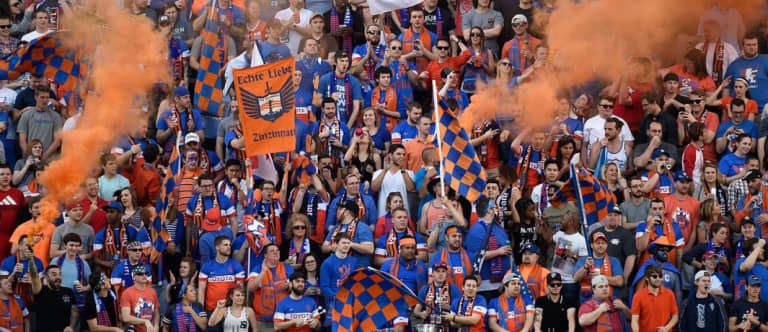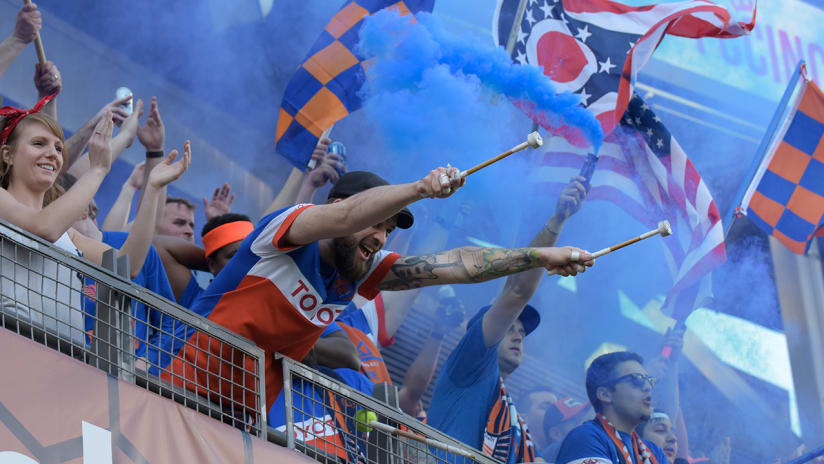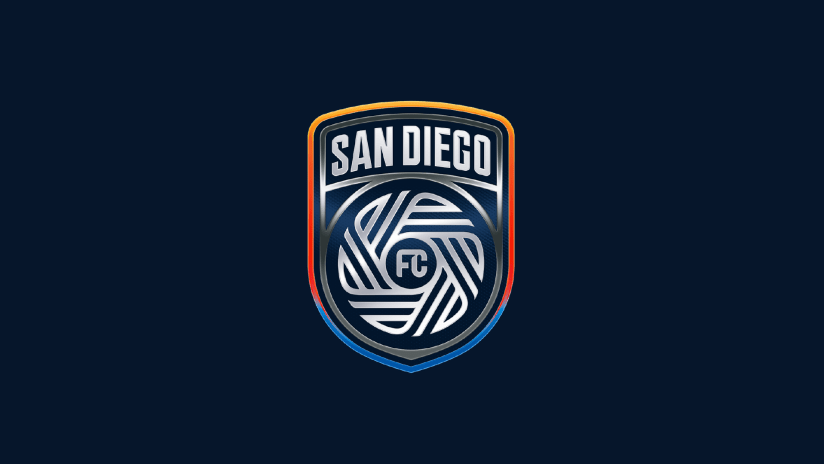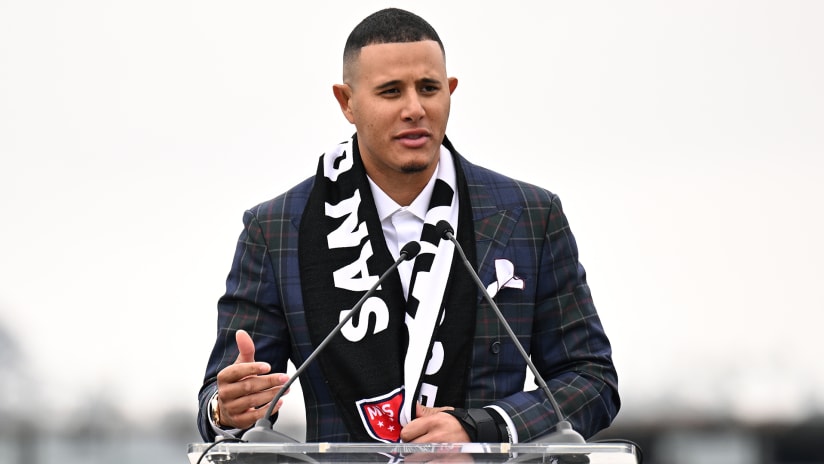On Saturday, leaders of a Cincinnati pro sports franchise are hoping to draw 25,000 fans to their stadium for an afternoon matinee.
But it won't be to watch Major League Baseball’s Cincinnati Reds, who play later that night. Instead, hordes of fans are expected to make their way to the University of Cincinnati’s Nippert Stadium, where FC Cincinnati of the United Soccer League play just their fourth home game in franchise history.
And while 25,000 fans would eclipse Cincinnati’s own regular-season USL record – they sold 20,497 tickets for their second home game – the club’s sights are set even higher than fitting a few thousand more people into their building.
When the ownership group led by CEO Carl Lindner III announced that FC Cincinnati would be joining the USL for the 2016 season, they seemed armed with all the tools to succeed.
Lindner is a co-CEO at American Financial Group, while his father – Carl Lindner Jr. – was a part owner of the Reds and has appeared on Forbes magazine’s list of the world’s richest people.
Jeff Berding was named president and general manager, and brought 19 years of experience, including stints with the Cincinnati Bengals and as a member of the Cincinnati City Council.
The club hired former US national team and MLS midfielder John Harkes to his first head coaching job and gave him the freedom to build a team that would play attractive soccer in the midst of a market that contains 50,000 youth soccer players.

That core of experience influenced the club from day one.
“Everything we do, I think about, ‘How would we want to do it with the Bengals?’” Berding said. “John thinks about, ‘How would we do it with D.C. United or with the men’s national team?’”
But FC Cincinnati were fighting history.
Teams have been failing in the city since the Cincinnati Comets played in the American Soccer League in 1972. The Comets folded in 1975 and the Cincinnati Kids, partially owned by baseball legend Pete Rose, lasted just two years in the Major Indoor Soccer League.
After 13 years, the Cincinnati Cheetahs of the United States Interregional Soccer League managed to last four seasons and were followed by the Cincinnati Silverbacks, Riverhawks, Excite, Kings, 1790 Cincinnati Express, the Saints and the Dutch Lions.
Prospective fans were aware of those failures and at first, it affected excitement.
“There have been a lot of teams to go through here over the years,” said fan and University of Cincinnati graduate Jared Handra. “A lot of great owners have tried to bring soccer here and haven’t been able to make it work. So at first, we were all like, ‘Well, here comes another one. Let’s see if it sticks.’”
Lindner says he knew it would “stick” all along, provided the ownership group and team leadership could capitalize on a Cincinnati market that Berding says has “tremendous upside.”
“I’ve kind of been keeping my eye on professional soccer for a while,” Lindner said. “With the great sports town that Cincinnati is and the loyal fanbase that exists here for other sports, I think there’s been a great, pent-up demand by all those youths over the last 30 years to have someone to root for and get behind and have fun with.”
So Berding plunged forward in Cincinnati, bringing the decision-making from the NFL’s Bengals into the soccer world and using his knowledge of the Cincinnati market.
“In Cincinnati, if you think about everyone’s favorite sports teams, they have certain things in common,” he said. “All their games are on radio and TV, so all our games are on radio and TV … We have a stadium that people would associate with big-time sports … All of that was critical for the market to appreciate that we’re doing this at a high level.”
And the market noticed.

Before their first match, the club had sold more than 4,000 season tickets. By kickoff of their first-ever home game on April 9, 14,600 people had showed up to watch the match. By that point, Handra had become one of the leaders of Die Innenstadt, a supporters group with German flair.
The club, he said, was inescapable within the city.
“They’re just there,” Handra said. “You see it everywhere. I don’t know if it comes down to marketing or the brand. But you just see it everywhere. You can’t get away from it, and that’s something that’s never really been done here, I don’t think.”
In their first three matches, the club is averaging about 15,000 fans, and team leadership admitted FC Cincinnati’s debut season has been better than they could have imagined.
“We’re having a higher level of success sooner than we anticipated,” Berding said. “We were certainly confident that the soccer market in Cincinnati is strong, but we wouldn’t have predicted averaging 15,000 people through three home games. The Cincinnati area has responded in a tremendous manner.”
Even the players can’t believe what has transpired in the stands beyond the pitch.
Omar Cummings signed with the club in the offseason, one of several MLS veterans to do so, and was recovering from injury when the season began.
“Being in the stands, actually watching the game and seeing the fans, I got more of a fan perspective,” he said. “It was great. It was phenomenal.”

Cummings, who was an all-Big East forward with the University of Cincinnati, said he’s been surprised by the entire situation. When he watched from the stands as the franchise scored its first goal at home, he said it was his favorite moment so far.
“The stadium just erupted,” he said. “To feel that energy, to feel that roar, everyone had a blast.”
Despite dominating USL headlines and attendance numbers, FC Cincinnati leaders aren’t counting their achievements. Their sights have been set high since the franchise formed.
Berding says he believes the team’s early success is sustainable. To facilitate that, the team has increased in-stadium vendors by 50 percent, ordered more merchandise for game-day sales, opened every concession stand in Nippert and is furiously hiring ticket sales representatives to handle demand.
They even need more Verizon hotspots to connect all the credit card transactions happening within the stadium.
“We have problems, but they’re good problems to have,” he said.
But since the very beginning of the franchise, Berding and ownership have made it clear that they’ve got MLS aspirations on their minds. While the club is less MLS-focused in the midst of the current season and is “thrilled” to be in the USL, acknowledging those aspirations was an important message to potential fans and those interested in the franchise.
“When we launched in August, the greater Cincinnati market – the business community, the news writers, the fans, the civic leaders – they wouldn’t have a whole lot of familiarity with the USL, but I think most people generally know about MLS,” Berding said. “We felt it was important to put it out there that the USL is an aspirational league, and Cincinnati views ourselves as a big league town … We had to let people know that long-term, we would have the goal to be like an Orlando City and have an opportunity to be promoted. People had to understand where we fit and what our goals were.”
Berding believes in installing a professional atmosphere from top to bottom.
That mentality made Harkes’ appointment crucial. Berding says he believes in order to capitalize on the Cincinnati market – its massive group of youth soccer players in particular – he’ll need to give them an enjoyable product.
“We certainly hired a coach that has maybe an unrivaled network in US soccer and parts of Europe,” Berding said. “When we hired [Harkes], we felt he would be a very effective recruiter, very successful at identifying talented players to play an entertaining brand of soccer. We wanted to be a pressing team. We wanted to be a team that plays possession with a purpose and is scoring a lot of goals.”
Cummings said the team has the ambition to be “one of the top teams” in USL in just its first season. And while it’s early, FC Cincinnati is just three points off the best record in the league, despite playing only eight competitive games together.

“This club has been trying to do things right,” Cummings said. “It’s as professional as I’ve seen. They’re not going to get everything right from the get-go, especially being a new club. But I’ve been impressed with everything they’re doing so far … If they’re not getting stuff right and players say, ‘I think we could do things better,’ they try to improve upon it.”
Despite acknowledging those aspirations, FC Cincinnati is taking the moment to enjoy the success that’s surprised even their leaders.
And while plans for an academy system are on the horizon and a 15-year lease at Nippert Stadium might cast doubts on short-term MLS viability, no one can rain on FC Cincinnati’s parade.
“It’s off-the-charts exciting for me and my whole family and all of our partners,” Lindner said. “We’re having a heck of a lot of fun and I think in life, that’s as important as business success. It’s about passion and enjoying what you’re doing.
“How fun is it to bring something from the ground up and see it flourish?”













